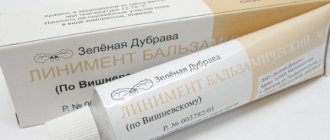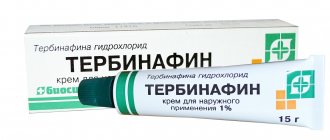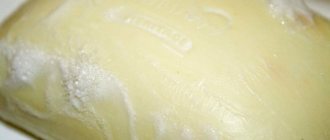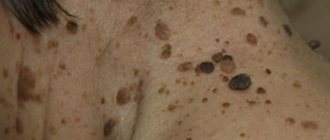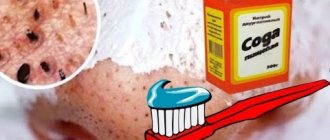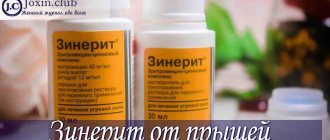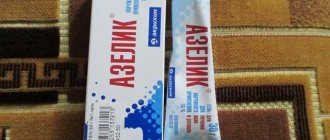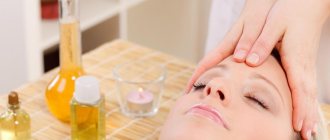The drug Doxycycline is an antibiotic of semi-synthetic origin and belongs to the tetracycline group of drugs.
It has a wide spectrum of action and is prescribed for many infectious diseases and lesions of various organs and systems of the body.
One of the common reasons for using Doxycycline is the regular appearance of a large number of pimples. Treatment with this drug becomes possible after agreeing on the course with a specialist.
Description of release forms and composition
The main active component of the drug Doxycycline is the substance of the same name – doxycycline.
It is thanks to its effect that various types of infections are eliminated, and positive results are achieved in the fight against acne.
Doxycycline can be purchased at pharmacies in the following forms:
- Oral capsules - each capsule contains 100 mg of doxycycline hydrochloride;
- Powder - intended for self-preparation of an injection solution.
When treating acne, only Doxycycline is used in capsule form, each package contains 10 or 20 pieces.
How does doxycycline work?
The drug accelerates the healing process and restoration of skin damage (subcutaneous inflammation, purulent wounds, skin damage, etc.). It has an antimicrobial effect against various pathogenic microorganisms (staphylococci and streptococci).
This product copes well with purulent rashes. It is also suitable for those who want to get rid of subcutaneous acne on the face and body.
Doxycycline capsules from the company Belmedpreparaty
The principle of action of the drug and beneficial properties for the skin
The effectiveness of the drug is ensured by doxycycline hydrochloride, thanks to this substance, bacterial microflora is destroyed, while the drug does not affect fungal infections and viruses.
After its application, the following action mechanism is launched:
- Rapid absorption through the gastrointestinal tract;
- Penetration into bacterial cells;
- Suppression of protein synthesis processes;
- Termination of bacterial activity.
The following properties of Doxycycline help solve acne problems:
- Destroying pathogenic microflora in the intestines and normalizing its functioning. Infectious diseases of the digestive system often provoke the appearance of acne, so it is necessary to eliminate not the secondary symptoms, but the main cause;
- Detrimental effect on microorganisms sensitive to the composition and located in the upper layers of the epidermis;
- Providing natural protection and minimizing the risk of secondary infections that can aggravate the acne problem;
- Detrimental effect on subcutaneous mites , if the appearance of acne and general deterioration of the skin is associated with the pathological activity of this parasite.
What properties does the medicine have?
Reviews from doctors and patients indicate that Doxycycline really helps get rid of acne. This drug is a semi-synthetic antibiotic of the tetracycline group and is characterized by a pronounced bacteriostatic effect. In particular, the active substance inhibits the process of protein synthesis at the ribosome level.
Gram-positive bacteria such as staphylococci, streptococci, listeria, clostridium, as well as some gram-negative microorganisms, including salmonella and E. coli, are sensitive to doxycycline. In addition, the drug affects rickettsia, chlamydia, mycoplasma and treponema.
Once in the digestive tract, doxycycline hydrochloride is quickly absorbed and penetrates into the blood - the maximum concentration is observed after two hours. Eating does not affect the degree of absorption of this substance. Doxycycline is 93% bound to blood proteins. Approximately 40% of the substance is excreted by the kidneys, and the remaining 60% is excreted from the body along with feces. With long-term use, the antibiotic can accumulate in tissues.
Indications for use
The use of Doxycycline is possible not only for the treatment of skin rashes on different parts of the body, such as the back, head and face, but is also necessary in the acute course of infectious diseases.
The main indications are:
- Syphilis;
- Various types of chlamydia;
- Various forms of diphtheria and typhus;
- Inflammation of the gallbladder;
- Burns and open wounds when secondary infections are introduced into them;
- Purulent and necrotic skin lesions caused by pathogenic bacteria;
- Foci of purulent lesions in soft tissues, including the formation of abscesses;
- Inflammation of the urethra or bladder;
- Infectious lesions of peripheral joints;
- The risk of purulent inflammation during the rehabilitation period after surgical interventions.
The principle of doxycycline against acne
Like most bacteriostatic antibiotics, its action is to suppress the protein synthesis of microorganisms. Thus, doxycycline prevents bacteria from multiplying and paralyzes them, subsequently removing them from the body.
Antibiotics in the hands of people who want quick relief from acne can turn from a medicine into a weapon for the proliferation of the same acne. Dermatologists rarely prescribe doxycycline if there are not many acne, the severity is not more than moderate and the acne is located in local areas. After all, you need to try to remove these problems with external medications. But, if most remedies do not help you in any way against acne, you should consult a dermatologist and start taking a course of doxycycline.
How to take it correctly to fight acne?
Doxycycline capsules are suitable for treating acne. The attending physician can always make adjustments to the treatment regimen depending on the state of health, the causes of acne and the severity of the symptoms.
Standard dosage regimen for adult acne patients:
- On the first day, take 2 tablets: morning and evening;
- Starting from the second day, you need to take 1 tablet per day;
- 200 mg of doxycycline is the maximum permissible daily dosage;
- The duration of the course is determined individually, taking into account the positive dynamics, the number of pimples and the causes of their occurrence. Treatment can last from 1 week to 1.5 months.
In case of a large number of pimples or their acute inflammation, take 2 tablets per day throughout the course.
Preparatory procedures before external use of Doxycycline
External use of Doxycycline is also practiced to solve problems associated with acne.
In this case, you will need to go through some preparatory procedures:
- Wash the affected areas of the skin with warm water , using mild soap or any neutral skin care product;
- The washed area of skin must be dried , but avoid putting excessive pressure on it, so it is best to lightly blot it with a soft towel or napkin, and then let it air dry naturally;
- Preliminarily spot treat acne with hydrogen peroxide using a cotton swab.
- Make sure there are no contraindications for the use of Doxycycline;
- To do an allergy test - to do this, dilute one capsule with a few drops of water, apply the resulting paste to your wrist for 20 minutes, then rinse. If no unpleasant symptoms occur, you can safely use the antibiotic externally.
Mode of application
Recommended method of using Doxycycline:
- 200 mg per day (in two doses) on the first day, 100 mg on all subsequent days for adults and adolescents.
- If skin rashes are severe and more serious intervention is required, the dosage can be increased to 200 mg daily.
- The length of the course will depend on how serious your problem is. It can vary from 7 days to six months.
Your doctor will tell you more precisely how to take it and in what dosage, focusing on the individual characteristics of your body. Self-administration of the drug is not recommended; it is prescribed only after the microorganism that has become the causative agent of acne has been identified.
Effect of use
If the drug was taken as prescribed by a doctor after identifying the type of microorganism that caused acne, in the process you will note that:
- New rashes appear less frequently or do not appear at all.
- The skin is cleansed.
- Inflammatory processes caused by bacteria are reduced and cause less and less discomfort.
Only a full course of use will lead you to a cure for acne. Therefore, listen to your doctor and do not stop taking the capsules on your own. And do not forget about proper skin care, and do not squeeze out the remaining pustules on the skin.
Doxycycline-based masks
The best way to fight acne with Doxycycline is to use masks at home.
Standard mask based on Doxycycline and cosmetic clay
Doxycycline is used as an auxiliary component for various masks to reduce the number of acne.
Below is a recipe and method of using a standard product based on this drug and cosmetic clay:
- Take 1 tablespoon of any cosmetic clay and dilute it with water to obtain a thick paste;
- 5 Doxycycline tablets are crushed to a powder and added to the composition;
- The components are thoroughly mixed, the resulting homogeneous mass is applied to the face in even layers;
- You must wait until the mask has completely dried, after which it can be washed off with warm water;
- The course is required for 3-4 weeks, the procedure is carried out 2 times a week.
Cosmetic clay contains a large amount of minerals and substances beneficial to the skin; adding Doxycycline to it increases the antiseptic properties of the product.
Egg mask with the addition of Doxycycline
Egg masks are suitable for treating acne on dry skin. They normalize impaired metabolism and stimulate the natural protective functions of the skin. After using the product, color improves, skin elasticity increases and pigmentation is eliminated.
The recipe for preparing and using such a mask is as follows:
- Take 1 raw chicken egg, which will need to be beaten and then mixed with powder obtained from several capsules of Doxycycline;
- As additional components, use 1 teaspoon of olive or wheat oil, 10 grams of potato starch. After introduction into the composition, the mass is thoroughly mixed;
- The mass is applied in equal layers to the affected area, it can be washed off after 15 minutes;
- Depending on the degree of damage, you can take a course for 3 weeks with 2 procedures per week or a week course, applying masks to the affected areas daily.
The addition of Doxycycline to the composition allows you to eliminate various infections located in the upper layers of the epidermis and provide protection against their reappearance.
Milk mask with the addition of Doxycycline
There are various options for milk masks; the recipe discussed below is suitable for treating acne on oily skin.
The use of the product is recommended if acne occurs due to increased activity of the sebaceous glands, since the mask helps normalize their work.
The effectiveness is enhanced by the addition of Doxycycline, which will provide reliable protection against the addition of infectious microflora.
You can prepare and apply the mask using the following recipe:
- It is necessary to mix 2 ground Doxycycline capsules with 20 grams of flour;
- About 50 ml of milk is added to the dry mixture to make a thick paste; to prepare a mask, it is recommended to choose a product with a reduced fat content;
- At your discretion, you can add a small amount of any essential oil or spices to enhance the effect;
- The thoroughly mixed mass is evenly applied to areas of skin with acne.
- After 8 minutes, rinse off the mask with warm, clean water;
- The procedure can be performed 1-2 times a week, the course duration is 1-1.5 months, depending on the presence of positive changes.
Doxycycline based chatter
In the treatment of acne, a mash based on Doxycycline and Dimexide is highly effective.
Thanks to the combined action of these drugs, the following results can be achieved:
- Elimination of pathogenic microbial and bacterial microflora;
- Reducing inflammation;
- Elimination of pain;
- Acceleration of healing of damaged tissues;
- Less pronounced fibrinolytic effect.
Instructions for preparing and using mash are described in detail below:
- 20 Doxycycline tablets are crushed to a powder;
- The powder is dissolved in a liquid mixture - 150 ml of distilled water or injection solution and 50 ml of Dimexide in the form of a solution;
- Mix the resulting product thoroughly ; it is recommended to keep it in a transparent container;
- Before the first use, the mixture should sit for 24 hours ; the container should be shaken periodically;
- The mash is used to treat areas of skin with acne 2 times a day , in the morning and evening hours;
- After each use of the product, the skin must be treated with a cream with a moisturizing effect;
- The duration of the full course is 3 weeks , after which you must take a break.
Doxycycline for acne. Reviews
Dima: “Doxycycline really helped me deal with acne. True, it took a long time to be treated. But the most important thing is that now there are no these hated ulcers on my face. I recommend this simple remedy to everyone.”
Lana: “Indeed, doxycycline is good for acne. But I was only able to drink two days of the full course. After all, I had terrible nausea. But my friend had none of this. And she completed the full course of treatment. The medicine really works."
Ksyusha: “Does doxycycline help with acne? Don't know. I have been taking this drug for a month now. But so far there is no visible effect. Maybe there will be a result later.”
Use during pregnancy and lactation
Pregnancy at any stage is a direct contraindication for the use of Doxycycline, since the substances of the drug are able to cross the placental barrier.
Violation of this prohibition can lead to the following developmental disorders of the fetus:
- Pathological accumulation of fat in liver cells;
- Pathologies of dental development;
- Exhaustion and lack of normal development of the musculoskeletal system.
The active ingredient of the drug can penetrate into mother's milk, so lactation will also be a contraindication. If there is an urgent need to use the product, breastfeeding should be stopped.
During pregnancy, Doxycycline can be used externally, but under the strict supervision of a dermatologist.
Description of Doxycycline
Doxycycline is an antibacterial drug that belongs to the tetracycline group. The product is active against a large number of pathogens. As for the latter, resistance to Doxycycline is not yet widespread among them. This fact is one of the most important arguments in favor of this drug when selecting acne therapy.
Doxycycline has a bacteriostatic effect, that is, it inhibits the production of cell wall proteins of pathogens. The drug is also able to penetrate inside the affected cell, suppressing the proliferation of bacteria located there. This explains the effectiveness of Doxycycline against mycoplasmas and chlamydia.
The drug is quickly absorbed, after 2 hours it reaches its maximum concentration in the body, and after a minimum period of time from the start of administration it begins to act. Doxycycline is able to penetrate many tissues and organs. Eliminated from the body by the liver within 24 hours.
It is important to note that the drug has an accumulating effect; it is deposited in bone tissue and on tooth enamel, changing their color. This phenomenon does not pose any danger, but it can cause a cosmetic defect that has to be removed.
Use in childhood
The drug can be used to treat children over 12 years of age. In case of urgent need, Doxycycline can be prescribed for the treatment of children over 8 years of age under the supervision of a pediatrician.
When using the product in childhood, changes are made to the dosage regimen:
- On the first day of treatment , the dosage is calculated from the ratio of 4 mg of active substance per 1 kg of child’s body weight; the received dose is divided into 2 doses;
- Starting from the second day , the calculation is based on the ratio of 2 mg per 1 kg of the child’s body weight; reception is also carried out 2 times a day;
- The duration of the course is determined by the doctor and can range from a week to a month ; in the case of children, treatment must be reduced as much as possible.
Children over 14 years of age can use the drug according to the same regimen as for adult patients. If your body weight is less than 45 kg, the drug is not prescribed, regardless of age.
Instructions for use and approximate dosage
Once your dermatologist prescribes you the anti-acne drug Doxycycline, he will also select the appropriate dosage and dosage regimen. In most cases, a single dose is 100 mg, which corresponds to one tablet or capsule. The drug should be taken twice a day with plenty of water (to avoid irritation of the esophageal mucosa).
How long should you take Doxycycline for acne? The course of treatment in most cases is seven days. In more severe cases, therapy can last up to six weeks.
Special instructions for the use of Doxycycline
Before using Doxycycline, you should familiarize yourself with the following additional instructions:
- To facilitate the administration and absorption of the drug, capsules should be washed down with boiled water or low-fat milk;
- As an addition to the drug, antihistamines may be prescribed to prevent an allergic reaction;
- Additional use of drugs with probiotics and prebiotics is recommended , since antibiotics have a detrimental effect on the intestinal microflora;
- When completing the course, it is recommended to stop eating fermented milk products and drink plenty of water;
- When using the drug to treat acne, it is recommended to avoid exposure to direct sunlight and also avoid visiting solariums;
- The intake must be carried out in strict accordance with the instructions of the attending physician ; it is not allowed to take breaks or exceed the prescribed dosage.
Mechanism of action for acne
Doxycycline shows good results in the treatment of acne, since the drug quickly and effectively inhibits the vital activity and proliferation of bacteria that cause the disease.
The drug copes well with the inflammatory process, the number of pathological formations while taking the antibiotic is significantly reduced. The appearance of the skin is noticeably improved.
It is important to note that using Doxycycline as the only treatment may not produce the desired effect. In most cases, acne is caused by a large number of causes and factors that require systemic action. Bacteria are always present in the pathological chain of acne, but therapy in this direction alone will not be enough. Acne requires complex treatment, involving a large number of methods and drugs that act on other mechanisms of acne development. Only this approach will help a full recovery, and not a relief of symptoms.
Contraindications
You will have to refuse acne treatment with Doxycycline if you have the following contraindications:
- Pregnancy and lactation;
- Body weight less than 45 kg;
- Age under 12 years;
- Poor lactose tolerance;
- Impaired absorption of monosaccharides in the gastrointestinal tract;
- Pathologies of pigment metabolism with increased concentrations of porphin in the blood;
- Reduced content of leukocytes in the blood;
- Kidney diseases in severe form or at the acute stage;
- Intolerance to the active substance or the occurrence of side effects when taking other antibiotics from the tetracycline group.
Are there any contraindications for use?
Of course, this remedy is very effective. However, not all categories of patients can take the antibacterial drug Doxycycline. By the way, not all people use it for acne. There are other indications for the use of this medicine. To begin with, it is worth noting that the mentioned antibiotic is not prescribed to children under eight years of age. In addition, contraindications include pregnancy and breastfeeding - an exception can only be made by the attending physician, and only if it is really necessary.
Severe liver and kidney diseases (including renal and hepatic failure) are also considered a contraindication. The drug is not prescribed to patients with porphyria, leukopenia, systemic lupus erythematosus. And, of course, the medicine should not be taken by people with hypersensitivity to any of its components.
Side effects
When taking Doxycycline there is a risk of the following side effects:
- Metabolic disorders and the development of anorexia;
- Increased levels of intracranial pressure and disruption of the central nervous system;
- Deterioration of appetite and changes in the state of natural microflora;
- Headache and tinnitus.
- Complex disorder of the digestive system, as well as nausea and diarrhea;
- Allergic reaction and urticaria;
- Changes in the chemical composition of the blood and an increase in nitrogen content in urea;
- Muscle and joint pain, aching sensation;
- Changes in the color of tooth enamel and gum sensitivity;
- Increased sensitivity to bright light and tearing.
Side effects
As stated in the instructions for use, doxycycline for acne is tolerated without any side effects. Only in rare cases may there be complaints about:
- Nausea.
- Vomiting.
- Edema.
- Itching.
- Skin rash.
- Dizziness.
- Sweating.
If you experience any unusual reaction while taking doxycycline to treat acne, you should definitely consult a doctor.
Author - Anna Mikhailova, dermatologist-cosmetologist of the first category, specialist at the Academy of Scientific Beauty. Especially for the site “Treating Acne”.
Is it possible to overdose?
If the permissible dosage of Doxycycline is exceeded, the following reactions occur:
- Neurotoxic effects on the liver;
- A sharp increase in intracranial pressure;
- Profuse vomiting;
- Convulsive reaction.
A specific antidote has not been developed; in case of overdose, the following measures must be taken:
- Immediate discontinuation of the drug;
- Artificial induction of vomiting;
- Gastric lavage;
- Taking activated carbon;
- Taking magnesium sulfate;
- Taking pharmacological drugs belonging to the group of antacids.
If any signs of overdose occur, it is recommended to seek medical help.
Interaction and incompatibility with other drugs
The simultaneous use of Doxycycline and the following drugs with which it interacts undesirably is prohibited:
- Antibiotics belonging to the tetracycline group;
- Medicines with an alkaline environment or an environment with reduced stability;
- Any medications that contain magnesium, iron or calcium.
Other drug interactions are described below:
- When taking retinol-based drugs, the risk of changes in intracranial pressure increases;
- When taking drugs based on methoxyflurane, the risk of renal dysfunction increases; there is a threat of death;
- When taking drugs based on rifampicin or containing ethanol, the effectiveness of Doxycycline is reduced;
- Reduced effectiveness of antibiotics based on penicillin or cephalosporin.
Simultaneous use with indirect anticoagulants requires additional coordination with the attending physician; due to the nature of the effect, individual dose adjustment is often necessary.
Acne treatment with Doxycycline
Traditionally, short therapeutic courses are practiced to avoid the formation of resistance of microorganisms to the active substance. There are 2 options for treatment regimens:
- Taking the drug for 7-10 days at the usual dosage;
- Treatment with medication in low doses for 3-6 months.
Dermatologists with long-term clinical experience prefer the second regimen due to the fact that Doxycycline for acne is recommended for severe stages of the disease, the complete cure of which requires a long time.
Recommendations for the dosage regimen depend entirely on the severity of the disease and the general well-being of the patient. For a short course, it is recommended to take the medicine in the morning and evening with an interval of 10-12 hours.
A significant effect in the treatment of severe acne is achieved by treatment with Unidox Solutab, which contains a smaller amount of active substance. The treatment course lasts about 3 months and allows you to achieve positive dynamics and stable remission without negative effects on the body systems.
- It is important to take doxycycline with plenty of water or milk;
- At the same time, take medications to maintain normal intestinal microflora and, if necessary, antihistamines;
- During therapy, consume more fermented milk products;
- Avoid direct sunlight;
- Avoid combinations with medications that contain iron, magnesium, calcium, other tetracycline antibiotics, and alkaline medications;
- Strictly follow the prescribed dosages and medical recommendations.
Possible analogues
In some cases, when the use of Doxycycline is impossible, one of the following drug analogues may be prescribed:
- Unidox Solutab - produced in Holland, available in the form of tablets based on doxycycline. The cost is 300-350 rubles ;
- Vibramycin
- has a similar composition; the concentration of the substance in tablets can be 100 and 200 mg.
The average cost of the drug is 530 rubles .
Unidox Solutab Vibramycin
All analogs of the drug, like Doxycycline, can be purchased in pharmacies only if prescribed by your doctor. Self-prescription of the drug is not allowed.
Doxycycline analogues
Analogs of this drug include any tetracycline antibiotic.
In the table below you can see the compatibility of doxycycline with other antibiotics, and where there is a ++ sign, you can safely say that the antibiotic is similar. And when used together, their antibacterial activity increases.
You can buy other broad-spectrum antibiotics at the pharmacy that also help with acne. The most used and effective drugs include the following:
Metronidazole . Has a strong drying and antibacterial effect. At the pharmacy you can buy Metrogyl gel, which helps to cope with acne. Tablets are also sold that are added to masks and talkers.
The cost of the drug is from 11 to 150 rubles.
Streptocide . This product kills germs and prevents their proliferation. It is better to use in the presence of purulent inflammation. Has a pronounced bacteriostatic effect.
Price - from 20 to 70 rubles.
Flemoxin . Broad-spectrum antibiotic. Suitable for making masks, lotions and pimples against acne.
Cost - 350 rubles.
These medications are used externally, but to enhance the effect, some of them are taken orally. The drugs have contraindications and can cause side effects. The duration of the course of treatment, frequency of administration and dosage are determined by the attending physician.
If you want to supplement a mash or mask with an additional antibacterial component, thereby increasing its effectiveness, then consider exactly those drugs that are marked with two pluses.
